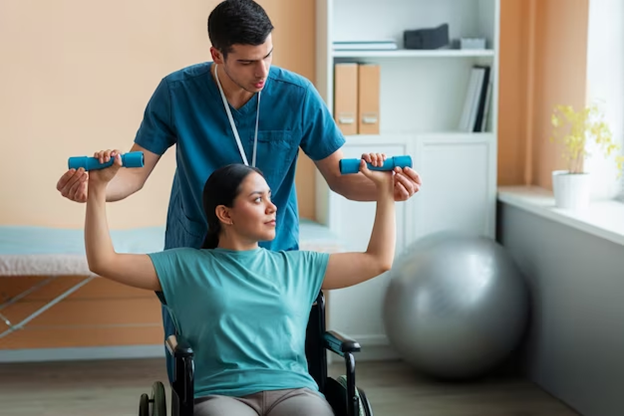Occupational Therapy Assistant
Our Occupational therapy assistants and or aides graduates help patients develop, recover, improve, as well as maintain the skills needed for daily living and working. They help people with illnesses, injuries and disabilities to overcome problems and be as independent as possible. In addition they work under Occupational Therapists to work out what the client’s needs.
The program duration may vary, but it typically spans two years. Graduates of this program will be prepared for careers as licensed occupational therapy assistants, working in hospitals, rehabilitation centers, schools, and other healthcare settings to help patients regain functional independence.

Diploma in Occupational Therapy Assistant
Duration: Typically 2 years (varies by program).
Prerequisites: High school diploma or equivalent.
Trimester 1: Foundations of Occupational Therapy
- OTH 100: Introduction to Occupational Therapy
- Overview of the occupational therapy assistant profession
- Role in patient rehabilitation and healthcare
- Ethical considerations in occupational therapy
- APHY 100: Anatomy and Physiology
- Study of human anatomy and physiological systems
- Understanding the musculoskeletal and nervous systems
- Common diseases and conditions affecting mobility and function
- MEDT 100: Medical Terminology and Patient Communication
- Medical vocabulary and terminology
- Effective communication with healthcare professionals and patients
- Interpreting and documenting patient information
- OTTEQ 100: Occupational Therapy Tools and Equipment
- Introduction to occupational therapy tools and equipment
- Assistive devices and adaptive techniques
- Safety procedures and patient handling
Trimester 2: Occupational Therapy Techniques and Interventions
- OTHEA 100: Occupational Therapy Assessment
- Patient evaluation and assessment techniques
- Identifying functional limitations and goals
- Patient-centered care and goal setting
- PTMT 100: Patient Transfer and Mobility Training
- Safe patient handling and transfer techniques
- Mobility training and gait analysis
- Improving patient independence in daily activities
- TAEX 100: Therapeutic Activities and Exercise
- Designing and implementing therapeutic activities
- Exercise programs for strength, flexibility, and endurance
- Monitoring patient progress and adjustments
- CLIDR 100: Clinical Documentation and Reporting
- Recording patient progress and goals
- Documentation standards and reporting
- Compliance with healthcare regulations
Trimester 3: Clinical Experience and Specializations
- CLIEXP 100: Clinical Experience
- Hands-on clinical practice in rehabilitation settings
- Implementing therapy interventions and techniques
- Working with a team of healthcare professionals
- PGOT 100: Pediatric and Geriatric Occupational Therapy
- Specialized care for pediatric and geriatric patients
- Meeting the unique needs of different patient populations
- Sensory integration and cognitive rehabilitation
- POT 100: Psychosocial Occupational Therapy
- Addressing psychosocial issues and mental health in therapy
- Behavioral management and coping strategies
- Supporting patients with emotional challenges
Trimester 4: Licensure Preparation and Final Assessments
- LEPREP 100: Licensure Exam Preparation
- Review of the occupational therapy assistant licensure exam
- Mock exams and test-taking strategies
- State-specific requirements and regulations
- FASSC 100: Final Assessments and Certification
- Successful completion of clinical experience and training
- Successful performance in the licensure exam
- Graduation and award of the Diploma in Occupational Therapy Assistant
Students have to contact the school administration if they want to take extra credits or transfer credits to pursue the Diploma Certificate or Associate of Applied Science (A.A.S.) Degree in their field of interest. Students will select required number courses in each of the areas listed to meet general education requirements graduation for the A.A.S. Some of these courses can be transferred directly from and to the university system and may be substituted for recommended courses on the outline. Students should speak with an advisor before doing so these selective courses are required for all students.
- Selected Communication Course (Choose two for Diploma or three for the Associate)
ENGL 100: Fundamentals of Speech
CPL 100: Career Planning
CPL 101: Communications and Career Strategies
ENGL 101: Composition
ENGL 102: composition
- Selected Mathematics Course (Choose two for Diploma or three for the Associate)
MATH 100:General Math
MATH 101:Intermediate Algebra
MATH 102:College Algebra
- Selected Social Science Course (Choose two for Diploma or four for the Associate)
ECON 105:Leadership
ECON 101:Principles of Microeconomics I
ECON 102:Principles of Macroeconomics II
SOC 101:Introduction to Sociology
PSYC 101: Introduction to Psychology
HIST 101: History
